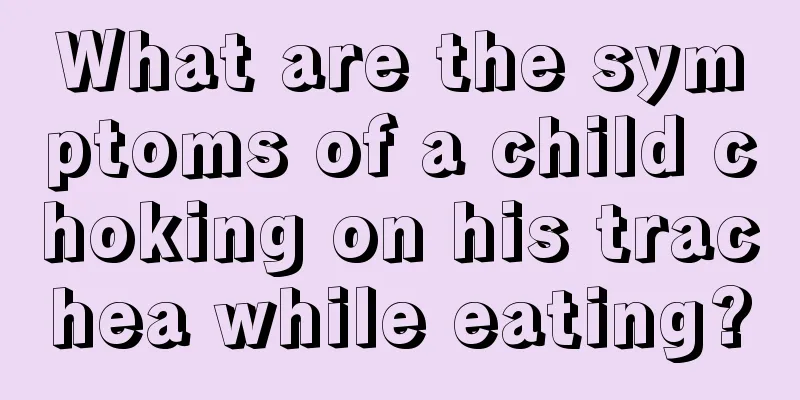What are the symptoms of a child choking on his trachea while eating?

|
If a child chokes on food while eating, parents need to be vigilant, because in many cases, if we do not pay attention and take timely measures to deal with it, it may even cause the child to suffocate. Therefore, we must pay attention when the child is eating. We cannot make them laugh while eating. We must create a good eating environment for the child. If the child has difficulty breathing or lack of oxygen, we must take timely measures. 1. Foreign body entry period Most patients experience sudden choking, violent coughing and choking during eating, and may experience wheezing, hoarseness, cyanosis and dyspnea. If the foreign body is small, smooth and movable, such as melon seeds or corn kernels, a slapping sound of the foreign body hitting the glottis can be heard when the patient coughs, and a vibration can be felt when the hand is placed in front of the larynx and trachea. If the foreign body is large and blocks the trachea or is close to the bulge of the tracheal branch, the ventilation of the main bronchi on both sides may be seriously obstructed, resulting in severe dyspnea, or even suffocation and death. 2. Quiet period If the foreign body is small and not very irritating, or if it enters the bronchus through the trachea, the symptoms of coughing and shortness of breath may be very mild or even disappear for a period of time, and there may be a long or short asymptomatic period, making it easy to overlook the diagnosis. 3. Irritation or inflammation period Plant-based tracheal foreign bodies contain free acids, which have a significant irritating effect on the tracheal mucosa. Bean-based tracheal foreign bodies swell after absorbing water, making airway obstruction more likely to occur. The longer the foreign body stays in the airway, the more severe the reaction will be, initially causing an irritating cough, followed by increased secretions in the trachea and swelling of the tracheal mucosa, resulting in symptoms of persistent cough, atelectasis or emphysema. 4. Complication period Foreign bodies can get stuck in one bronchus and be wrapped by granulation or fibrous tissue over time, causing bronchial obstruction and prone to secondary infection. Long-term tracheal foreign bodies have clinical manifestations similar to purulent tracheitis, with bloody sputum, atelectasis or emphysema, and cause breathing difficulties and hypoxia. |
<<: When is the vaccination schedule for children?
>>: What to do if your child has rhinitis and nasal congestion
Recommend
What to do if your five-year-old baby is grinding his teeth
Teeth grinding in a five-year-old baby is a big p...
Baby's two feet are always rubbing together
Some parents will find that their babies always r...
The important role of zinc supplementation in children and the importance of zinc supplementation in babies
Zinc is an important element needed by the human ...
How to take care of baby's eye mucus
Many parents and friends will find that their bab...
What causes white spots on a child's face?
When parents see some skin problems on their chil...
How to check for developmental disabilities in children?
When a child's body has any abnormality, it w...
How fast does your baby's feet grow?
A baby's feet usually grow quite fast. The gr...
What exactly is going on with my baby's cough and wheezing?
Many new mothers become very anxious when they fi...
What should children pay attention to when filling their teeth
Children's teeth are relatively fragile, and ...
Age group of children
Children are the flowers of the motherland and th...
Can children play rafting?
In real life, rafting is a popular entertainment ...
What is the normal body temperature of a 1-year-old baby?
The baby's body temperature is more easily af...
My child is always distracted in class
If children want to achieve excellent results, th...
Newborn breastfeeding knowledge
Newborns cannot eat any other food in the first f...
Why are babies easily awakened when sleeping?
Every mother hopes that her baby can get enough s...









